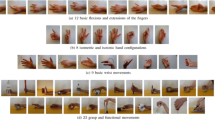Abstract
This article mainly studies the motion recognition method used in the human-centered smart systems. First, we learn feature encoding sequences of the training sets, and then extract subactions from the learned sequences using a statistical model. Based on the hierarchical probabilistic context-free grammar characterization of limb sequences, we generate the grammatical rules of different actions according to the action training sets and characterize the actions and subactions using the finite state machine (FSM). To measure each limb sequence matching degree, we introduce a weight factor of the limb to perform gesture recognition. Also, we can get two sets of the compatibility of recognition probability when identifying the same limb movement sequence. Base on the endings, we derive the feature probability fusion formula of two sets of characteristics of limb movement sequence. Finally, we give the recognition results of two experiments and show the effect of the proposed method on several typical actions. The experimental results show that the proposed action recognition method applied on the same dataset has better recognition accuracy and less time cost over the other methods.












Similar content being viewed by others
References
Hancke G, de Carvalho e Silva B, Hancke G (2013) The role of advanced sensing in smart cities. Sensors 13(1):393–425
Luo X, Zhang D, Yang LT, et al. (2016) A kernel machine-based secure data sensing and fusion scheme in wireless sensor networks for the cyber-physical systems[J]. Futur Gener Comput Syst 61:85–96
Morello R, Mukhopadhyay SC, Liu Z, et al. (2017) Advances on sensing technologies for smart cities and power grids: a review[J]. IEEE Sensors J PP(99):1–1
Xu Y, Luo X, Wang W, et al. (2017) Efficient DV-HOP localization for wireless cyber-physical social sensing system: a correntropy-based neural network learning scheme:[J]. Sensors 17(1):135
Shotton J, Sharp T, Fitzgibbon A, Blake A, Cook M, Kipman A, Finocchio M, Moore R (2013) Real-time human pose recognition in parts from single depth images. Commun ACM 56(1):116124
Omelina L, Jansen B, Bonnechere B, Oravec M, Pavlovicova J, Jan SV (2016) Interaction detection with depth sensing and body tracking cameras in physical rehabilitation. Methods Inf Med 55(1):70–78
Lee MY, Han B, Jenkins C, Xing L, Suh TS (2016) A depth-sensing technique on 3D-printed compensator for total body irradiation patient measurement and treatment planning. Med Phys 43(11):6137–6144
Koppelhuber A, Bimber O (2017) Computational imaging, relighting and depth sensing using flexible thin-film sensors. Opt Express 25(3):2694–2702
Zhao W, Lun R, Gordon C, Fofana AM, Espy DD (2017) A human-centered activity tracking service: towards a healthier workplace. IEEE Transactions on Human-Machine Systems 47(3):343–355
Luo X, Xu Y, Wang W, Yuan M, Ban X, Zhu Y, Zhao W (2017) Towards enhancing stacked extreme learning machine with sparse autoencoder by correntropy Journal of the Franklin Institute. https://doi.org/10.1016/j.jfranklin.2017.08.014
Luo X, Deng J, Wang W, Wang JH, Zhao W (2017) A quantized kernel learning algorithm using a minimum kernel risk-sensitive loss criterion and bilateral gradient technique. Entropy 19(7):365. https://doi.org/10.3390/e19070365
Luo X, Deng J, Liu J, Wang W, Ban X, Wang JH (2017) A quantized kernel least mean square scheme with entropy-guided learning for intelligent data analysis. China Communications 14(7):127–136
Aggarwal JK, Xia L (2014) Human activity recognition from 3D data: a review. Pattern Recogn Lett 48:70–80
Antonio V, Erickson N, Gabriel O, Zicheng L, Mario C (2012) STOP: space-time occupancy patterns for 3d action recognition from depth map sequences, pp 252–259
Kviatkovsky I, Rivlin E, Shimshoni I (2014) Online action recognition using covariance of shape and motion. Comput Vis Image Underst 129:15–26
Siddharth N, Barbu A, Siskind JM (2014) Seeing what you’re told: sentence-guided activity recognition in video. In: 2014 IEEE conference on computer vision and pattern recognition, Columbus, OH, pp 732–739
Li S-Z, Yu B, Wu W, Su S-Z, Ji R-R (2015) Feature learning based on SAECPCA network for human gesture recognition in RGBD images. Neurocomputing 151(2):565–573
Du Y, Wang W, Wang L (2015) Hierarchical recurrent neural network for skeleton based action recognition. In: 2015 IEEE conference on computer vision and pattern recognition (CVPR), Boston, MA, pp 1110–1118
Chen C, Jafari R, Kehtarnavaz N (2016) A real-time human action recognition system using depth and inertial sensor fusion. IEEE Sensors J 16(3):773–781
Zhu W, Lan C, Xing J, Zeng W, Li Y, Li S, Xie X (2016) Co-occurrence feature learning for skeleton based action recognition using regularized deep LSTM networks. In: Proceedings of the thirtieth AAAI conference on artificial intelligence (AAAI’16). AAAI Press, pp 3697–3703
Gu Y, Do H, Ou Y, Sheng W (2012) Human gesture recognition through a kinect sensor. In: 2012 IEEE international conference on robotics and biomimetics (ROBIO), Guangzhou, pp 1379-1384
Lu X, Chia-Chih C, Aggarwal JK (2012) View invariant human action recognition using histograms of 3D joints. In: IEEE computer society conference on computer vision and pattern recognition workshops, pp 20–27. https://doi.org/10.1109/CVPRW.2012.6239233
Manning CD, Sch1tze H (1999) Foundations of statistical natural language processing. MIT Press, Cambridge
Chen C, Jafari R, Kehtarnavaz N (2015) UTD-MHAD: a multimodal dataset for human action recognition utilizing a depth camera and a wearable inertial sensor. In: 2015 IEEE international conference on image processing (ICIP), Quebec City, QC, pp 168–172
Brown PF, deSouza PV, Mercer RL, Della Pietra VJ, Lai JC (1992) Class-based n-gram models of natural language. Comput Linguist 18(4):467–479
Funding
This work was supported by The National Key Research and Development Program of China (Grant No. 2016YFB1001404).
Author information
Authors and Affiliations
Corresponding author
Additional information
Publisher’s note
Springer Nature remains neutral with regard to jurisdictional claims in published maps and institutional affiliations.
Rights and permissions
About this article
Cite this article
Ban, X., Zhang, D., Sun, J. et al. An action identification method based on FSM and limb dry weight. Pers Ubiquit Comput 25, 1051–1061 (2021). https://doi.org/10.1007/s00779-019-01279-0
Received:
Accepted:
Published:
Issue Date:
DOI: https://doi.org/10.1007/s00779-019-01279-0




